The iPad Air Review
by Anand Lal Shimpi on October 29, 2013 9:00 PM ESTGPU Performance
Since the iPad Air uses the same A7 silicon as the iPhone 5s, it also uses the same on-die GPU as the 5s: IMG’s PowerVR G6430. This is a 4-cluster configuration of IMG’s latest graphics hardware, running at some relatively high frequency. I already went into some detail on the G6430 in our 5s review so I won’t rehash that here, but we’re basically looking at a shift to a more efficient scalar architecture.
I still don’t have confirmations of clock speeds, but I believe we’re looking at a max GPU clock of around 450MHz. As you’ll see from the results below, there’s a small difference in performance between the iPad Air and iPhone 5s in terms of peak GPU performance - implying very similar clocks. The difference is the iPad Air should be able to sustain its max frequency longer than the iPhone 5s can.
| Mobile SoC GPU Comparison | ||||||||||||
| PowerVR SGX 554MP4 | PowerVR G6430 | PowerVR G6430 | ||||||||||
| Used In | iPad 4 | iPhone 5s | iPad Air | |||||||||
| SIMD Name | USSE2 | USC | USC | |||||||||
| # of SIMDs | 32 | 4 | 4 | |||||||||
| MADs per SIMD | 4 | 32 | 32 | |||||||||
| Total MADs | 128 | 128 | 128 | |||||||||
| GFLOPS @ 300MHz | 76.8 GFLOPS | 76.8 GFLOPS | 76.8 GFLOPS | |||||||||
| GFLOPS as Shipping | 68.1 GFLOPS (?) | 115.2 GFLOPS | 115.2 GFLOPS | |||||||||
Since we’re talking about an A7 here and not an X-series SoC, there’s still only a 64-bit wide memory interface. As memory bandwidth is a key enabler of GPU performance I was curious to see how GPU performance compared to the outgoing iPad 4 with its much wider memory interface. Do keep in mind that the A7 does include a large system cache on-die, which can help improve effective memory bandwidth.
GFXBench 2.7
We'll start our GPU performance analysis with a look at low level results using GFXBench/GLBenchmark 2.7. The low level tests, particularly the offscreen ones, should give us some idea as to whether or not there's any increase in GPU frequency for the iPad Air vs. iPhone 5s implementations of A7.
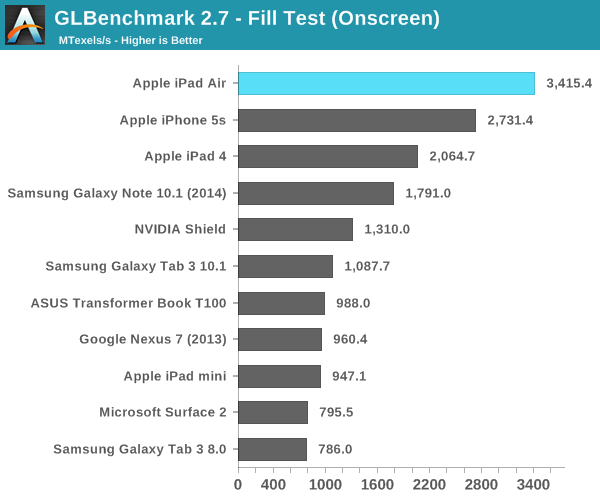
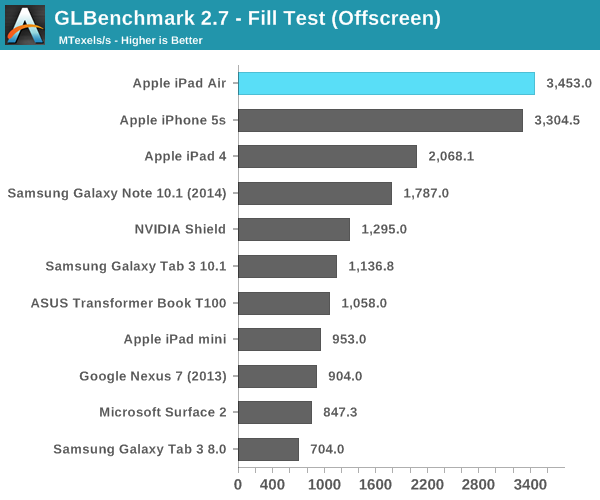
Looking at the fill rate results, there's a 4.5% increase in performance compared to the iPhone 5s. That could be the magnitude of clock increase that we're seeing between A7s. Apple could very well be relying on more thermal headroom in the iPad Air to provide any real world GPU performance advantages over the iPhone 5s.
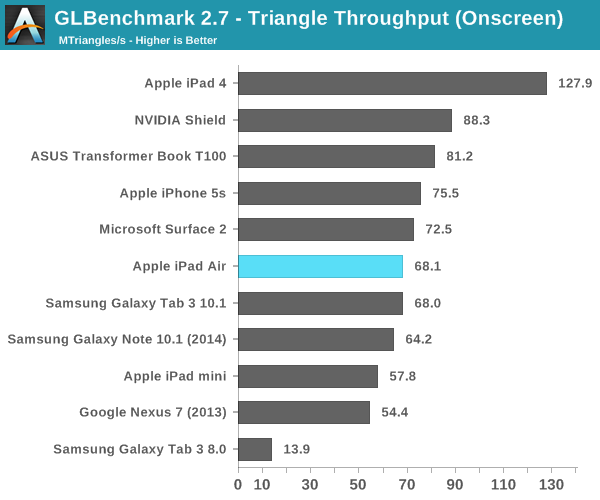

We see an even smaller gap between the Air and 5s in the triangle throughput tests (2.9%). There doesn't seem to be any substantial difference in GPU frequency between A7 implementations here. The regression in triangle rate performance compared to the iPad 4 is explained by differences in how Series 6 and Series 5XT GPUs scale in width. Whereas 5XT replicated nearly the entire GPU for "multi-core" versions, multi-cluster versions of Rogue only replicate at the shader array. The result? We don't see the same sort of peak triangle setup scaling we did back on multi-core 5XT parts. I'm not sure I'm particularly happy with the magnitude of the regression here, but I haven't seen any real world cases where it matters yet.
Next up are the game simulation tests. We'll start with the more strenuous of the two: T-Rex HD.
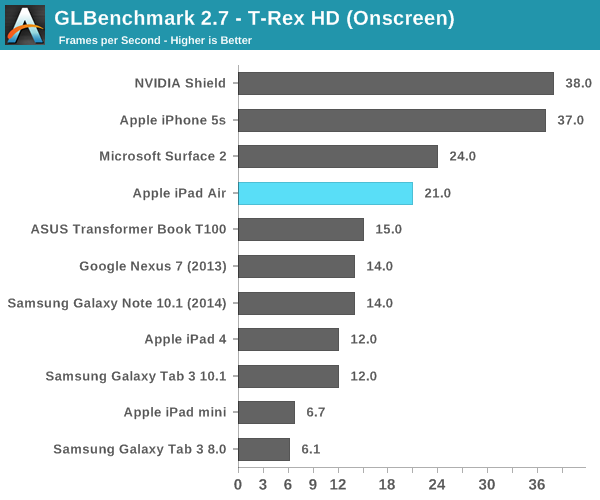
Here we get closer to Apple's claims of a 2x increase in performance. The iPad Air delivers 75% more performance than the iPad 4 in this test. Once again the iPhone 5s pulls ahead but that's because the onscreen tests render at display resolution, which is lower on the 5s.
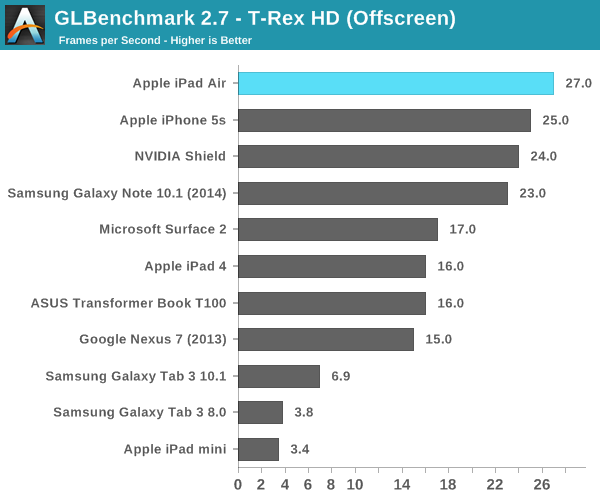
Offscreen performance sees similar scaling: ~69% better performance compared to the iPad 4.
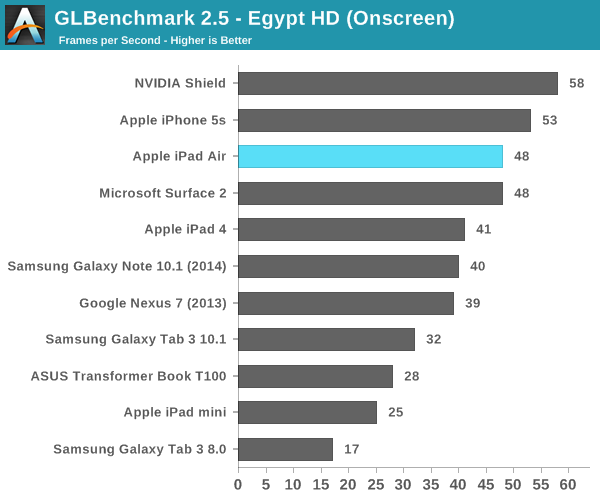
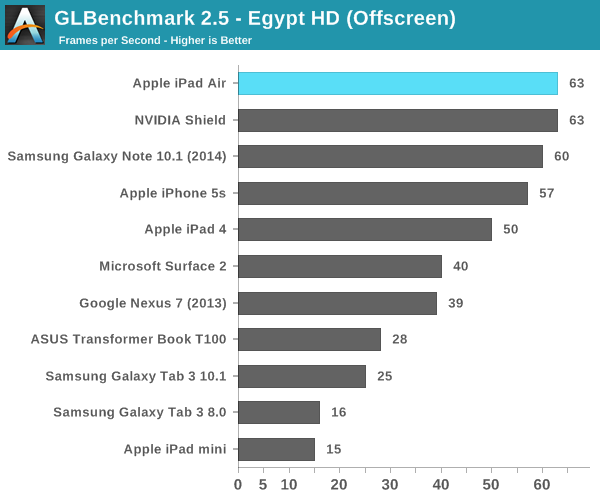
3DMark
We're once again running 3DMark's newest Unlimited mode which does its best to run independently of v-sync and at a standard resolution across all devices. I've also included 3DMark Extreme results below that feature a few more comparison points.
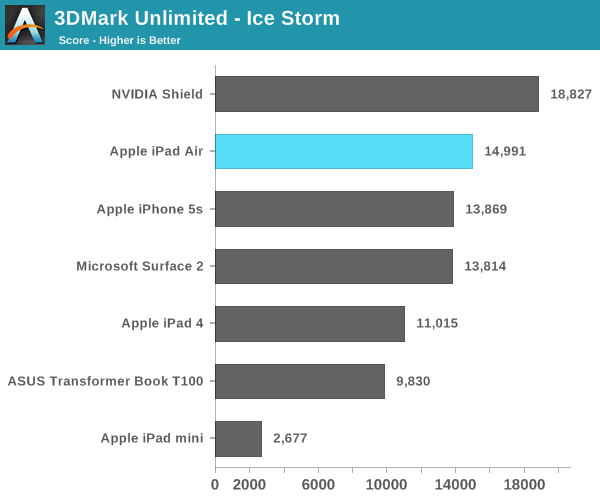
The overall Ice Storm scores show a 36% improvement in performance over the iPad 4 and an 8% increase compared to the iPhone 5s. Given the CPU frequency advantage of the A7 in the Air vs. the iPhone 5s, I'm guessing that's why we're seeing the performance gap we are here.
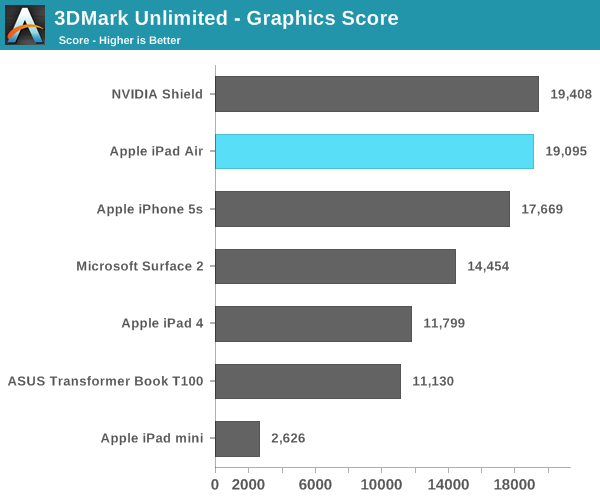
If we focus exclusively on the GPU tests (which themselves are still CPU bound), the iPad Air's performance advantage over the iPad 4 grows to over 60%.
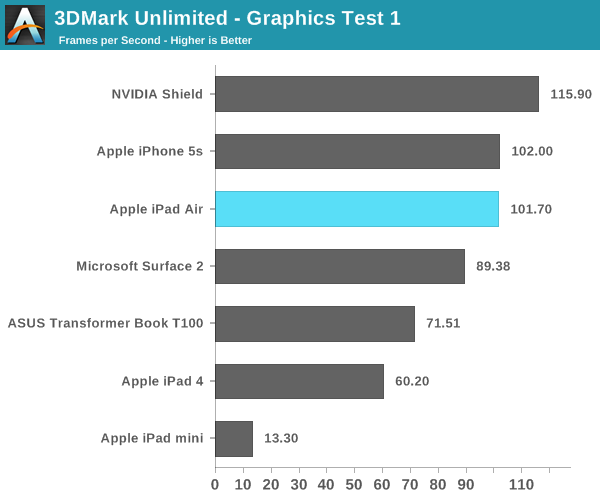
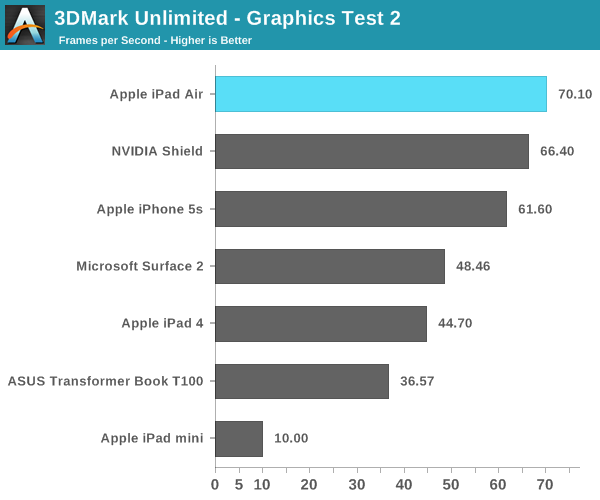
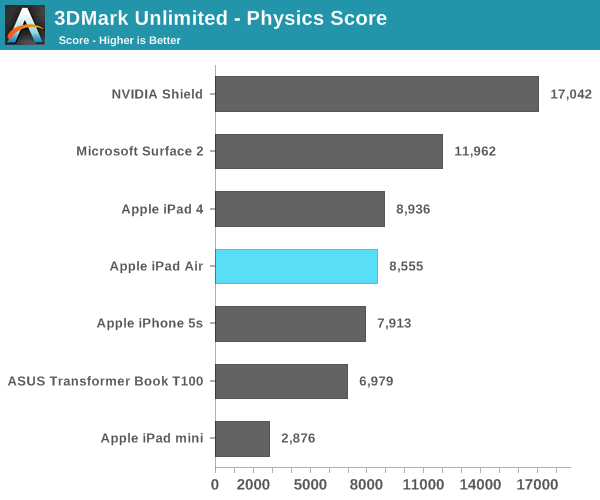
I'm still not entirely sure what's going on with the 3DMark Physics test, but we've seen this two reviews in a row now where Cyclone showed no performance increase at all compared to Swift despite this being largely a CPU test.
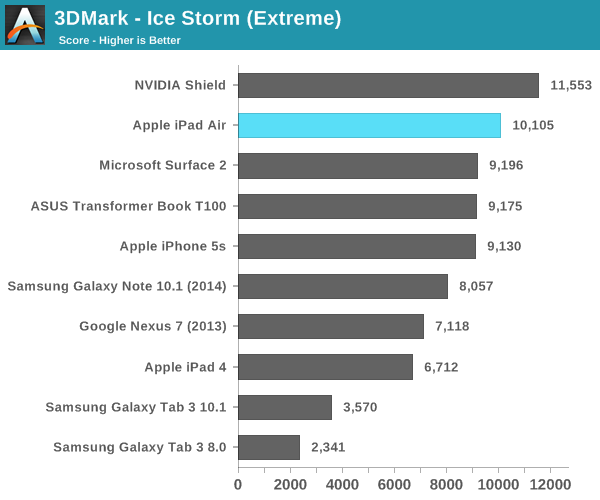
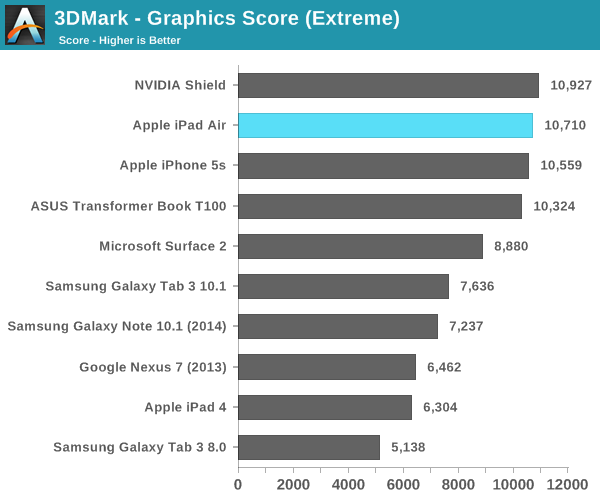
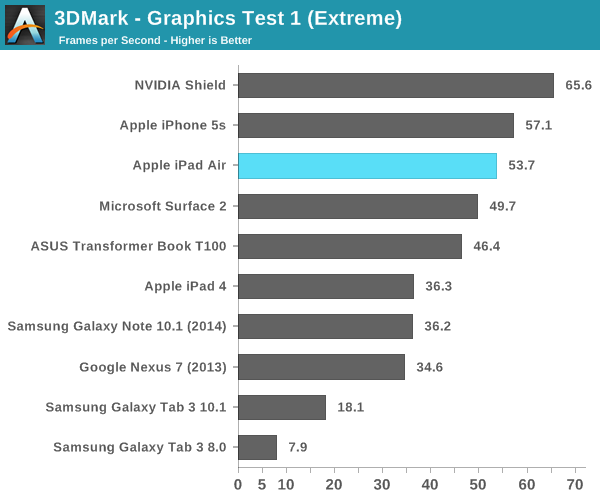
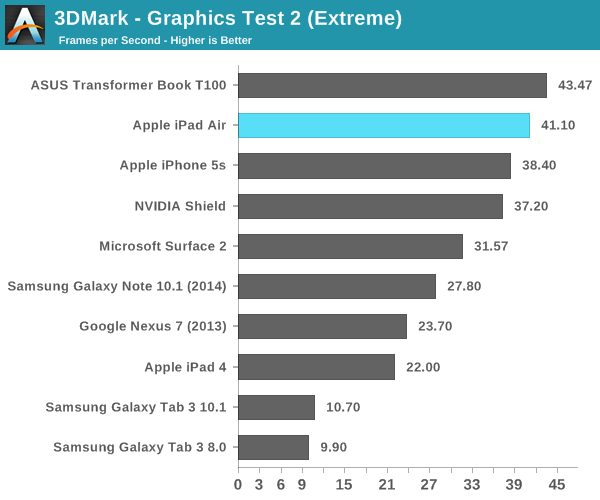

Basemark X
Basemark X is a new addition to our mobile GPU benchmark suite. There are no low level tests here, just some game simulation tests run at both onscreen (device resolution) and offscreen (1080p, no vsync) settings. The scene complexity is far closer to GLBenchmark 2.7 than the new 3DMark Ice Storm benchmark, so frame rates are pretty low.
I'm still having random issues with Basemark X reliably running both on and offscreen tests on iOS 7. Unfortunately I could only get onscreen results for the iPad Air, which came in at 46% faster than the iPad 4. Note the iPad mini and iPhone 5s benefit from having lower native resolutions here, which is why they perform so well.
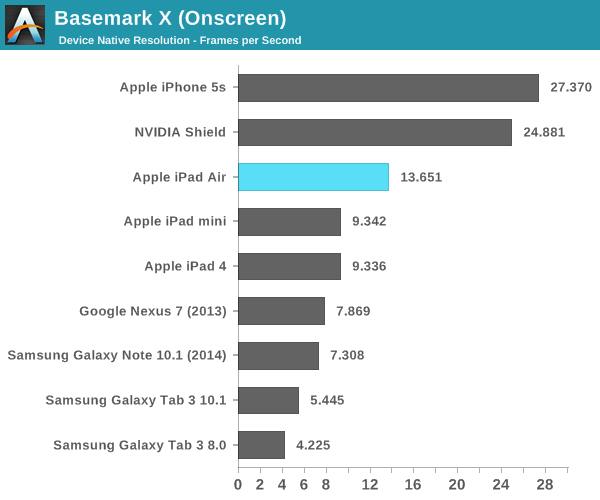










444 Comments
View All Comments
ssiu - Tuesday, October 29, 2013 - link
Still, when Apple claims "up to 2x GPU of iPad 4", usually you will find some aspect of GPU performance that reaches the 2x claim. "40% to 70% better" seem below expectation compared to the claim.MadMan007 - Tuesday, October 29, 2013 - link
Apple marketing slides vague, misleading, or contrived? NO WAI!FwFred - Wednesday, October 30, 2013 - link
With CPU power going up (eating into turbo/thermal headroom), I wonder where Apple is going to get their next 2x? TSMC/Samsung aren't moving fast enough for them. They have gone from toy CPUs to soon bumping against the limitations of physics.takeship - Wednesday, October 30, 2013 - link
My bet is on them shifting to Intel as a fab on their 16nm, but doing so prior to the A9 (2015) may be a stretch.tipoo - Tuesday, October 29, 2013 - link
How much does the GPU throttle? I was somewhat under the assumption that iPhones didn't have to throttle their CPUs as they never chased insane clocks like others (the infamous Nexus 4 throttling problem, also dialing back to 1GHz like here, not that the core performances are the same).errorr - Wednesday, October 30, 2013 - link
They still throttle it just takes longer. The other big advantage is just the pure SIZE of the chip which is what allows the lower clocks.Egg - Tuesday, October 29, 2013 - link
Can someone explain the extremely cold display? Is it not true that "closer to 6504k is better" anymore?Psyside - Wednesday, October 30, 2013 - link
Yes. Some people prefer over-saturated colors, 6500K is as closes to perfect as one can imagine, what he like or prefer is another story.For me 6500 sRGB displays are the only that matter, i can't stand 4500-5000K aka ARGB garbage.
cheinonen - Wednesday, October 30, 2013 - link
6504K is the reference standard, which is devised from the color temperature of daylight at a certain time (and latitude). Really, it's what colors will look like if you have them outside during a sunny day. During sunrise or sunset, or under clouds, the light spectrum is different, so you see things differently then.Getting a display to do 6504K is just that: making what you see on screen be what it looked like when it was shot or designed. If you want it to be warmer (for example, incandescent light bulbs are around 2700K which is a warmer reddish light) or cooler is a personal preference, but if its closer to D65 (the actual white point) it will be more neutral and accurate.
wiz329 - Tuesday, October 29, 2013 - link
What are your thoughts on the naming scheme @Anand?iPad Air is a pretty dumb name unless they're planning on releasing a Pro product.